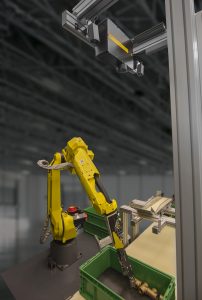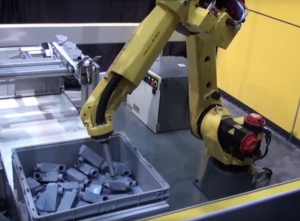
Robots bring new productivity; implications for MRO
While many warehousing facilities are well-equipped to handle the mechanical maintenance of their conveyors, they may lack the robotics and software resources to maintain a fully-automated system. And with many facilities shifting toward automation processes, robotic system maintenance will forge a new MRO culture that includes advanced training or experience in technology.
October 7, 2016 | By Giovanni Stone


Industry analyst firm Forrester Research reports that the rate of e-commerce has grown by about 14 per cent over the past four years and is likely to continue at that pace in the near future. (Figure 1). To keep up with that demand retailers are looking for ways to become more agile within their existing distribution and order fulfillment centers.

Figure 1 –U.S. CAGR of retail sales projected to grow by 9 percent through 2017, which is about three times that of U.S. CAGR
Moreover, the fact that a growing number of those purchases are made on mobile devices contributes to consumer expectations for an accelerated, personalized buying experience. To remain competitive, distribution centres are refining their operations to be able to handle higher volumes of smaller packages such as polybags, envelopes, corrugated boxes and totes of varying loads. This means more SKUs and smaller on-hand inventories per SKU, which leads to the need to handle smaller unit loads from receipt to shipment.
Robots to the rescue
Providing personalized fulfillment profitably requires high speed, intelligent selection with repeatability not achievable by humans. Enter robotics. Equipped with advanced imaging and motion technology robots can identify objects by shape, QR or other coding, move them adeptly from one place to another and maintain a history of all activity. Use of robots in retail distribution centres has been growing most rapidly in pick-and-place and sorting functions, but there is also use in truck and container loading, unloading and palletizing.
Bin and Case Picking
Where fulfillment and distribution centres have traditionally had to move large palettes of like objects to brick and mortar retail outlets, the e-commerce fulfillment and distribution centers are fulfilling orders directly to the consumer. The three most common robotic picking applications used to help meet these demands are structured bin picking, non-structured bin picking and case picking.

This automated system from Daifuku picks product from fixed shelving and places it into a storage location
In structured bin picking, products are placed in a structured bin that orients the product to a specific location. A robot with an attached vision system will locate the bin and pick the product to an outbound tote or carton. In non-structured bin picking, the robot uses vision or perception sensors to find the parts in a bin and place them in an outbound carton. And in case picking the uses perception technology is to locate a case on a pallet and pick it to a conveyor or to another pallet for shipment.
Sorting
Robots can also sort numerous products at high speeds. Guided by a vision system, they can select and separate hundreds of different types of objects that come into its view. This all but eliminates errors and inaccuracy that comes with manual sorting. Plus, all information can be integrated more easily with PCs or other computing devices which lends greater control and planning capability.
Truck / Container Loading and Unloading
Truck and container handling is another area in which robots boost productivity. Robotic technologies automatically load and unload cases as well as other products. In robotic truck loading, once boxes are packed, 3-D vision system-guided robots load them directly onto the floor of a truck or container. In unloading, the same type of 3-D vision system-guided robots locate cases inside the truck or container and unload them onto conveyor for transport to a palletizer or receiving sorter.
Palletizing / Depalletizing
While personalized fulfillment may require less palletizing, use of robots for packaging and palletizing is still prevalent in distribution centers and will require MRO attention. Robotic options for palletizing vary according to the structure of the goods the robot receives, whether they are stationery or moving and on the amount of human intervention is in the process.
Implications for MRO
While many warehousing facilities are well-equipped to handle the mechanical maintenance of their conveyors, they may lack the robotics and software resources to maintain a fully-automated system. This new technology can place excessive strain on MRO functions that are likely already over-strapped. Vulnerability is in new manual operations, automated transports and robotic and automated processes themselves.
Most of the newly introduced manual operations involve humans picking orders and placing them directly onto carts or pallets for subsequent processing by the robotic systems. In this case, use of robotics introduces a new arena for potential human error. This can usually be addressed through training staff to avoid problems related to handling and maintaining carts and any associate lift equipment that may be involved.
Using automated transport equipment such as conveyors in robotic systems presents new challenges because the systems will have multiple diverts and sorters. Operational issues that must be confronted include jammed products, emergency stops, impeded product flow and processing time constraints. Potential electrical issues include misaligned photo eyes, faulty hardware with vision systems, PLC faults and need for developing scheduled maintenance plans. Mechanical maintenance issues include tasks such as motor and gearbox replacement, belt tracking, belt stretch, and pneumatics leakage.
While process failures in manual operations and transport can be significant, most of the new challenges are related directly to the robotic operations themselves — picking and transporting goods on conveyors, document insertion, labelling and palletizing, truck loading and unloading. This includes need for workflow procedures for handling dropped cases, system diagnostics and scheduled maintenance. It also includes extensive documentation demands, keeping manuals up-to-date, and building fault-handling and recovery processes.
Robotic system maintenance also requires more advanced training or experience in high technology. Maintaining electromechanical gripping assembly, for example, requires knowledge on mechatronics — the integration of electronics, pneumatics and mechanics. Maintaining vision and perception technologies, such as 2D and 3D cameras, lasers and photo sensors, requires optical engineering competencies. New software maintenance competencies required include maintaining onboard machine electronics; integration of robotics with warehouse control systems (WCS) and computerized maintenance management systems (CMMS;) and database troubleshooting.
Rising to the occasion
With the allure and increasingly demonstrable benefits of robotic technologies it is not hard to see how a company could easily advance to automation that is beyond the capacity of its current resources. Where transition from manual operations to automated transportation can be accomplished with skilled local technicians; transition to fully -automated and robotic processes can be more daunting. Distribution centres address this either by staffing up internally, by collaboration with vendors or through complete outsourcing of robotic maintenance to their equipment vendor or other third party.
Most distribution and fulfillment centres tend to rely on collaboration with their vendors. This includes customized offerings involving classroom and online training, auditing and on-site maintenance. It may also include programs designed to deliver spare parts within 24 hours, with some vendors actually creating regionalized parts warehouses to ensure that their customers do not lose valuable down time and competitive advantage while waiting for replacement parts. This is increasingly being written into RFPs.
And some distribution centres — especially those transitioning to fully-automated operations — are finding it more cost-effective to outsourcing large chunks of functionality to vendors or other third parties. This ranges from 24/7 monitoring of automated lines to predict or correct failures to complete responsibility for maintenance of transport and robotic systems.
MRO transformation
Whether distribution centres staff up to manage the MRO challenges of automated distribution or rely more on vendors or other third parties, distribution centre and MRO culture will change dramatically. Ideally it will be a culture in which robots enhance the performance capabilities of humans rather than replace them, especially in enabling them to elevate MRO into its rightful position as a key factor in the profitability equation.
This article was submitted by Giovanni Stone is Director Wynright Robotics, Wynright Corporation. Visit the website at www.wynright.com.
